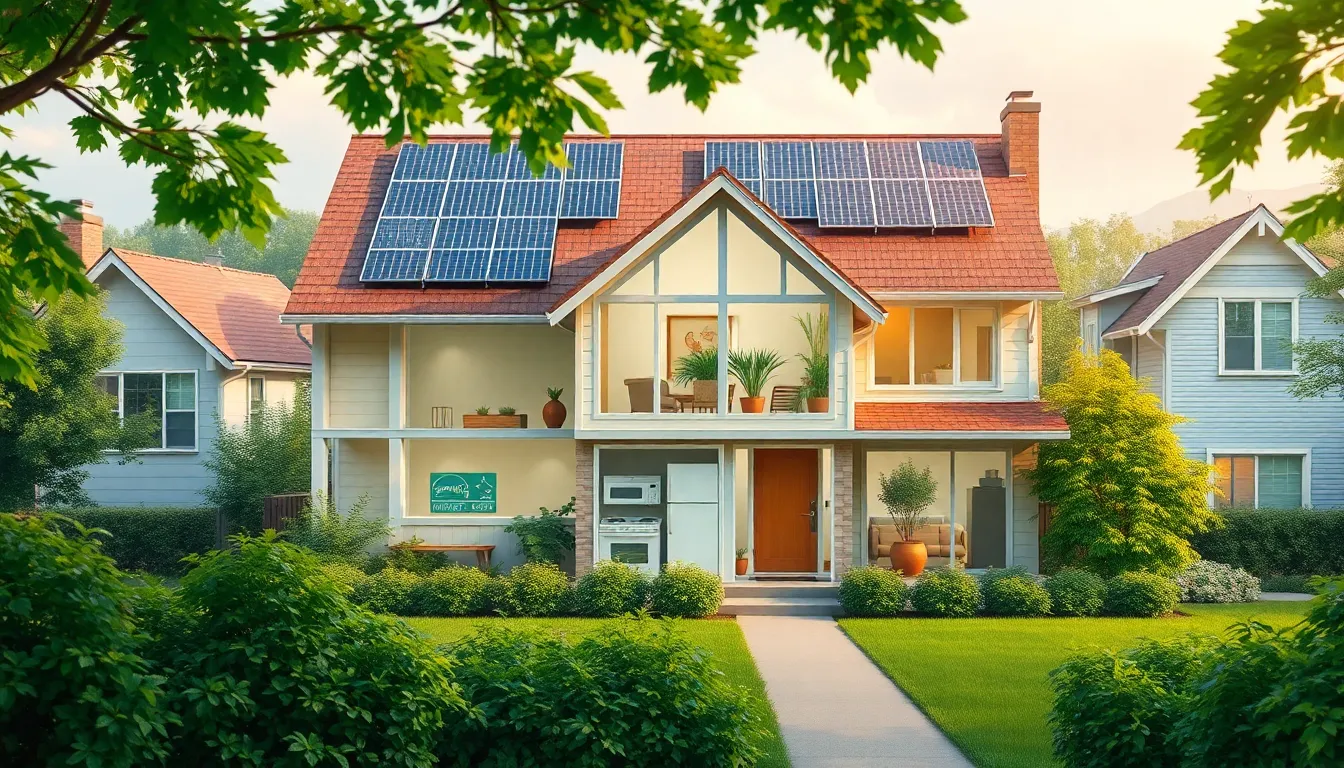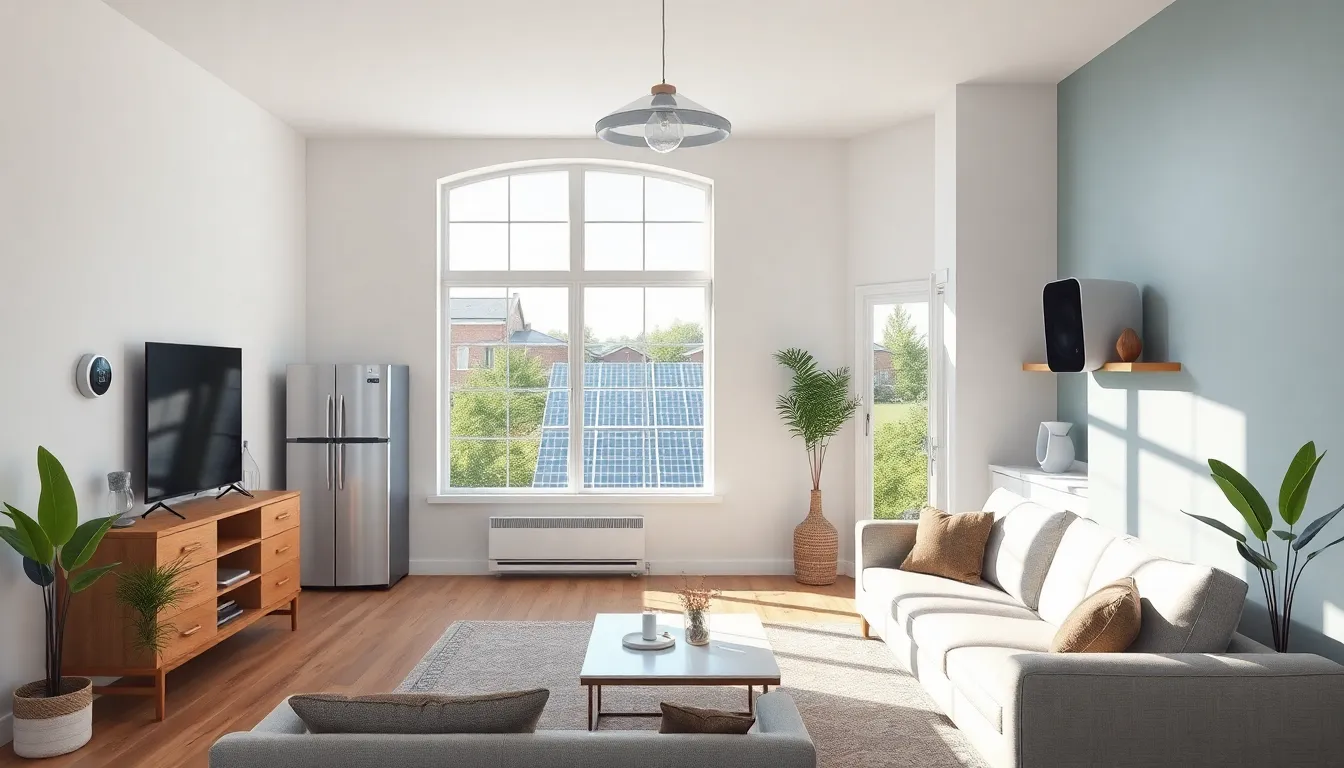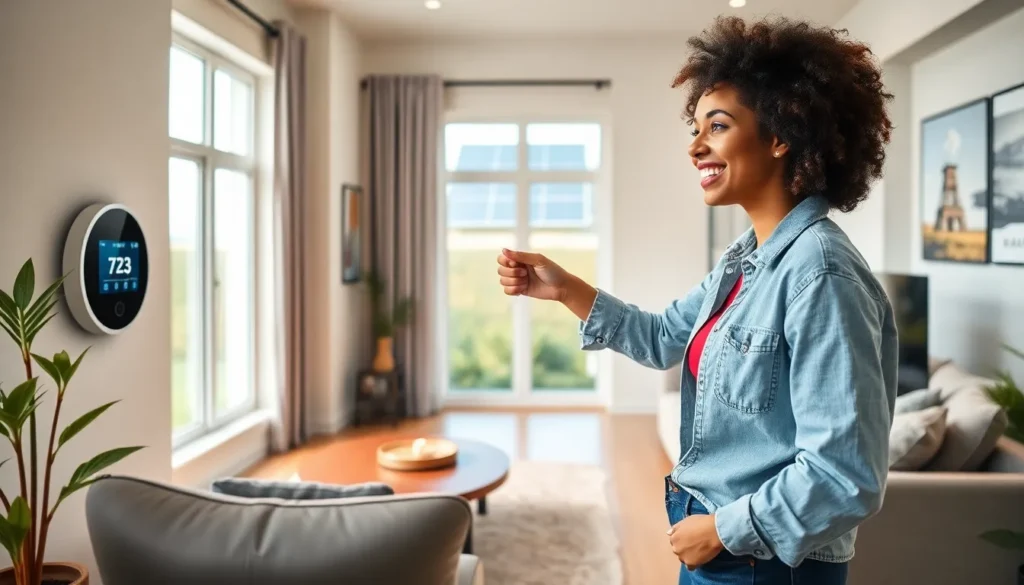Table of Contents
ToggleIn a world where energy bills can feel like a second mortgage, home efficiency tech is the superhero every homeowner didn’t know they needed. Imagine cutting those costs while reducing your carbon footprint—sounds like a dream, right? With the latest gadgets and gizmos, turning a house into an eco-friendly fortress has never been easier or more fun.
Overview of Home Efficiency Tech
Home efficiency tech includes a variety of tools and systems designed to optimize energy use and reduce waste. Smart thermostats, such as Nest and Ecobee, allow homeowners to program heating and cooling schedules. These devices adapt to lifestyle patterns, enhancing comfort while minimizing energy consumption.
Energy-efficient appliances, like Energy Star-rated refrigerators and washing machines, consume less electricity and water. Upgrading to these models results in significant savings on utility bills over time.
Home automation systems integrate various devices, creating a seamless experience. Systems like Amazon Alexa and Google Assistant control lighting, security, and climate remotely. Homeowners benefit from increased convenience and improved energy management.
Solar panels represent another crucial component of home efficiency tech. Installing solar panels reduces reliance on traditional energy sources. These systems harness renewable energy, significantly lowering electricity costs.
Smart lighting offers energy-saving possibilities through LED bulbs and occupancy sensors. LEDs consume up to 75% less energy than incandescent bulbs. Occupancy sensors automatically turn lights off when no one is in the room, further reducing energy waste.
Home energy monitors provide real-time insight into energy usage. Devices like Sense or Neurio allow homeowners to track consumption by specific appliances. Understanding energy usage patterns enables informed decisions on further efficiency improvements.
Incorporating multiple technologies creates a comprehensive strategy for energy efficiency. Homeowners experience reduced energy bills and lower carbon footprints while embracing a sustainable lifestyle. Home efficiency tech empowers them to take proactive steps toward energy conservation.
Benefits of Home Efficiency Tech


Home efficiency tech offers substantial advantages for homeowners, particularly in reducing energy costs and promoting sustainable practices. These systems create comfortable living environments while simultaneously minimizing waste and resource consumption.
Energy Savings
Energy-efficient technology translates directly into lower utility bills. Smart thermostats adjust heating and cooling based on user behavior, resulting in significant savings over time. Energy Star-rated appliances outperform standard models, using up to 50% less energy. Home automation systems optimize energy use by managing lighting and climate efficiently. The integration of smart lighting, such as LEDs and occupancy sensors, further enhances savings by ensuring lights only turn on when needed. Real-time data from home energy monitors helps homeowners track usage patterns and identify areas for improvement.
Environmental Impact
Reducing energy consumption contributes positively to the environment. Home efficiency tech decreases reliance on fossil fuels, thus lowering carbon footprints. Solar panels harness renewable energy, cutting down greenhouse gas emissions. Each energy-efficient appliance and system installed helps promote eco-friendly practices in households. When combined, these technologies create a larger collective impact, contributing to global sustainability goals. Emphasizing energy efficiency aids in preserving natural resources and combating climate change through measurable reductions in energy waste.
Types of Home Efficiency Tech
Home efficiency tech encompasses a variety of tools designed to enhance energy conservation and reduce costs. Integrating these technologies makes homes more sustainable and eco-friendly.
Smart Thermostats
Smart thermostats adjust heating and cooling based on occupancy and preferences. Nest and Ecobee adapt automatically, optimizing comfort while cutting energy use. Data shows these devices can lower energy bills by up to 15%. Programming schedules allows homeowners to set specific temperatures at different times, ensuring efficient usage throughout the day. Features like remote access through smartphones provide convenience, letting users control settings on the go. These smart devices contribute significantly to energy savings while enhancing home comfort.
Energy-Efficient Appliances
Energy-efficient appliances utilize less energy while performing everyday tasks. Products featuring the Energy Star label, such as refrigerators and washing machines, save homeowners substantial sums on utility bills. Studies indicate that these appliances use 10-50% less energy than standard models. Upgrading to energy-efficient options reduces overall consumption, leading to a smaller carbon footprint. Benefits include improved performance coupled with the reduction of greenhouse gas emissions. Investing in energy-efficient appliances not only supports sustainability but also enhances home value over time.
Solar Panels
Solar panels harness sunlight to generate renewable energy for homes. Installing these panels offers homeowners significant savings on electricity bills, particularly in sunny regions. Research estimates that solar energy can reduce reliance on traditional power sources by up to 80%. Additionally, incentives like tax credits encourage widespread adoption of this green technology. Solar installations improve property equity while contributing to a cleaner environment. With advancements in solar technology, systems become more affordable and efficient, making them an ideal choice for eco-conscious homeowners.
Implementation Tips for Homeowners
Homeowners can enhance energy efficiency with the right approaches and technologies. Consider the following tips for a successful implementation.
Cost Considerations
Investment in home efficiency technology varies. Smart thermostats typically range from $100 to $250, providing savings of up to 15% on energy bills. Energy-efficient appliances, like Energy Star-rated models, initially cost more but save 10-50% on utility expenses over time. For solar panel installations, expenses can reach between $15,000 to $25,000, with potential savings of up to 80% in solar-friendly areas. Home automation systems also involve setup costs from $200 to $500, but they streamline energy usage effectively. Assessing upfront costs alongside potential savings ensures optimal financial planning.
Maintenance and Upkeep
Regular maintenance ensures home efficiency technology operates optimally. Smart thermostats require software updates to access new features and improvements. Energy-efficient appliances necessitate periodic cleaning to maintain performance and efficiency. Maintaining solar panels simply involves occasional cleaning to prevent dirt buildup. Home automation systems should be updated regularly, ensuring compatibility and security. Investing a small amount of time for upkeep prevents larger issues and supports long-term energy savings.
Future Trends in Home Efficiency Tech
Emerging technologies reshape the landscape of home efficiency. Smart home integration continues to gain traction, with devices seamlessly connecting to enhance user convenience and energy conservation. Wireless systems that communicate with one another become increasingly sophisticated, setting the stage for a fully automated home environment.
Innovative energy storage solutions show promise in maximizing the benefits of renewable energy sources. Home battery systems store excess solar energy for later use, allowing homeowners to rely less on the grid during peak hours. These advancements can improve overall energy efficiency while offering significant savings on utility bills.
Trends in artificial intelligence pave the way for smarter home management. AI-driven systems analyze data patterns to optimize energy usage based on individual preferences and habits. Such systems can adjust heating and cooling settings in real-time, leading to reductions in energy waste.
Sustainable building materials gain momentum, emphasizing higher energy efficiency in new homes. Builders adopt insulation products with better thermal performance and low environmental impact, catering to eco-conscious buyers. Homes constructed with these advanced materials can achieve higher energy ratings, attracting a market focused on sustainability.
Smart HVAC technologies emerge as industry leaders in energy efficiency. Advanced heating and cooling systems employ variable speed motors and smart zoning to minimize energy consumption. Homeowners can expect up to a 30% reduction in heating and cooling costs through these innovations.
Home efficiency tech trends illustrate a commitment to sustainable living. As these solutions evolve, they drive down energy costs while enhancing comfort. Investing in these technologies not only benefits individual households but also supports broader environmental goals.







